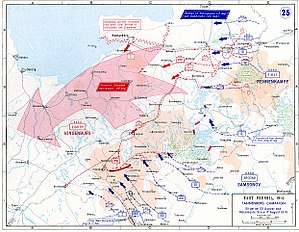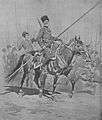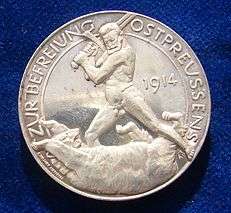Russian invasion of East Prussia (1914)
The Russian invasion of East Prussia occurred during World War I, lasting from August to September 1914. As well as being the natural course for the Russian Empire to take upon the declaration of war on the German Empire, it was also an attempt to focus the German Army on the Eastern Front, as opposed to the Western Front. Despite having an overwhelming superiority over the Germans in numbers, the invading Imperial Russian Army spread its forces thin and was defeated in the battles of Tannenberg and the Masurian Lakes.
| East Prussian Campaign | |||||||
|---|---|---|---|---|---|---|---|
| Part of the Eastern Front of World War I | |||||||
 Eastern Front, 17–23 August 1914. | |||||||
| |||||||
| Belligerents | |||||||
|
|
| ||||||
| Commanders and leaders | |||||||
|
|
| ||||||
| Units involved | |||||||
|
|
| ||||||
| Strength | |||||||
|
Total 250,000 men[1] Initially: 135,000[2] |
Total more than 800,000 men[3] Initially: 650,000[2] | ||||||
| Casualties and losses | |||||||
|
37,000[4]–100,000 men in total,[5] (Stallupönen - 1,300;[6] Gumbinnen - 14,600;[7] Tannenberg - 12,000;[8] Masurian lakes - 10,000[9] or 40,000[10][11][12]) | About 270,000–320,000 men in total, of them 100,000 taken prisoner[5] (Stallupönen - 7,500;[13] Gumbinnen - 19,000;[14] Tannenberg - 122,000–170,000;[15] Masurian lakes - 125,000[16]) | ||||||
German planning
German strategy vis-à-vis Russia was defensive from 1888 onward, when the Chief of the German General Staff, Helmuth von Moltke, abandoned the concept of a decisive offensive into Russian territory and began to consider defensive options.[17] According to German intelligence estimates, the railway network in Poland limited the Russians to three options: a purely defensive posture against Germany, an offensive down the Vistula straight towards Berlin or an invasion of East Prussia with two armies, one from the Narew and one from the Neman. French political pressure blocked the first option, while the second option was militarily unsound, leaving the third option as the most likely Russian course of action.[18]
In 1894 Alfred von Schlieffen, then Chief of the General Staff, war-gamed a scenario that corresponded to the Battle of Tannenberg in 1914. With the Russian Niemen army having overrun half of East Prussia, the German commander in the exercise exploited the separation between the Russian Narew and Niemen armies to mass his troops against the right flank of the Narew army and destroy the whole force. In the exercise critique Schlieffen said the Germans could easily just establish a defensive line behind the Vistula, but when the opportunity to destroy an entire Russian army was available, it should be taken.[19]
Whereas Schlieffen's predecessor's Alfred von Waldersee's idea had been to launch a spoiling attack on the Russians as they deployed and then wait for reinforcements from the west, Schlieffen foresaw a mobile operation on interior lines using railways to mass forces against one Russian army and destroy it before it could retreat. [20] As a result, every German general staff officer in East Prussia in 1914 knew how to respond to the Russian offensive.[18]
Comparison of strength
The invasion was led by two Russian armies: the First Army, which was commanded by General Paul von Rennenkampf and consisted of 6.5 infantry divisions, 5.5 cavalry divisions and 500 guns, and the Second Army under the command of General Alexander Samsonov, composed of 11 infantry divisions, 3 cavalry divisions and 720 guns. They were confronted by the German Eighth Army, commanded by General Maximilian von Prittwitz and consisting of 14.5 infantry divisions, 1 cavalry division and 1000 guns.[21] Although outnumbering the enemy, the Russian Army had numerous problems that contributed to its defeat: Russia was not prepared for a large war at the time and its rearmament programme was not completed,[22][23] as was known to the Germans.[24] Many soldiers were untrained,[25] its transport service was largely ineffective and slowed down the movement of troops, its forces were spread out over a large territory and had little coordination with each other, allowing the enemy to engage each part of their army separately,[26] like in the Battle of Tannenberg[27] or the Battle of Stallupönen,[28] and most importantly, its intelligence-gathering technique was greatly inferior to that of the Germans due to lack of reconnaissance units.[29] The planning of the invasion was rushed in order to help France as quickly as possible and not well-thought out.[30]
Battle
However, quite quickly, Russia was able to mobilize an invasion into East Prussia. Any invasion of Prussia was an important blow to German morale as well as her general strategic situation, due to Prussia (including East Prussia) being the historical heart of the German Reich (Empire). The German deployment on the outbreak of the war left only the 10 divisions of the German Eighth Army under General Maximilian von Prittwitz in East Prussia whereas the Russians had been able to mobilize the First Army, under General Paul von Rennenkampf and the Second Army, under General Alexander Samsonov. They entered East Prussia on 7–9 August. The Battle of Stallupönen, fought between Russian and German armies on 17 August 1914, was the opening battle of World War I on the Eastern Front. It was a minor German success, but did little to upset the Russian timetables.[31]
The Battle of Gumbinnen, started by the Germans on 20 August 1914, was the first major offensive on the Eastern Front during the First World War. Due to the hastiness of the German attack the Russian army emerged victorious. The Germans were forced to retreat, perhaps with the intention of performing holding actions in Masuria, or even retreating to the Vistula River which would have meant abandoning the salient of East Prussia. This would have fitted in with the plans made before the start of the First World War; that these were the positions the Germans would retreat to if the Russians put up a much stronger fight than they had anticipated. Regardless of whatever preparations had been made, however, it still remained that the Germans could not let the Prussian capital Königsberg fall into Russian hands. The moral, symbolic and military value (since it was a major military hub) of the city meant to lose it was to invite disaster on the home front, in addition to the strategic ramifications. Also, it was very likely that the Russians would have used the upper hand thus gained to use their superior forces to overwhelm the static German defenses. In short, the Germans had to fight back immediately and force the Russians from East Prussia.
Helmuth von Moltke the Younger, Chief of the German General Staff from 1906 to 1914 replaced Prittwitz with Paul von Hindenburg (brought out of retirement) on 22 August. Hindenburg, along with his Chief of Staff, the formidable Ludendorff would approach the crisis in East Prussia very differently from Prittwitz, who panicked when the Russian onslaught entered East Prussia. In contrast to Prittwitz, Hindenburg and Ludendorff decided to take the offensive and encircle one of the opposing armies. Following the plans of Colonel Max Hoffmann, Prittwitz's deputy chief of operations, they chose to send eight divisions against Samsonov in the Battle of Tannenberg resulting in over 90,000 captured and 70,000 killed or wounded. The Second Army was destroyed and Samsonov shot himself. In the Battle of the Masurian Lakes, the Germans forced the First Army to retreat out of East Prussia.
The invasion was a ghastly failure for the Russians, a setback which was followed by considerable German advances in the following year, including the capture of the Polish city of Warsaw. However, the crisis caused in the German High Command by the unexpected Russian advance forced the sending of 2 corps and a cavalry division from the Western Front as part of the new 9th Army in order to support the attack on the Russians. These additional forces did not arrive in time for the twin battles as Ludendorff predicted and, had they entered France as originally planned, could have been tremendously helpful to the precarious situation in the West. In the head of French Intelligence Colonel Dupont's words, "their debacle was one of the elements of our victory."[32][33][34]
Casualty estimates vary in different sources, from 37,000 to about 100,000 for the Germans and about 300,000, of which 100,000 were prisoners of war, for the Russians.
Gallery
 "To Prussia!", a drawing by Georges Scott for L'Illustration of 29 August 1914: "On the road to Berlin. The invasion of East Prussia by the Cossack avant-garde preceded the bulk of the Russian army."
"To Prussia!", a drawing by Georges Scott for L'Illustration of 29 August 1914: "On the road to Berlin. The invasion of East Prussia by the Cossack avant-garde preceded the bulk of the Russian army." The Chevalier Guard Regiment and the Life Guard Horse Regiment of the Russian Imperial Guard in Insterburg, East Prussia.[Note 1] The town was under Russian occupation from 24 August – 11 September 1914.
The Chevalier Guard Regiment and the Life Guard Horse Regiment of the Russian Imperial Guard in Insterburg, East Prussia.[Note 1] The town was under Russian occupation from 24 August – 11 September 1914. Obverse of a German silver medal commemorating the liberation of East Prussia in 1914 by Paul von Hindenburg.
Obverse of a German silver medal commemorating the liberation of East Prussia in 1914 by Paul von Hindenburg. Reverse of a German silver medal commemorating the liberation of East Prussia in 1914 by Paul von Hindenburg. The naked General Hindenburg is fighting the Russian Bear with his sword.
Reverse of a German silver medal commemorating the liberation of East Prussia in 1914 by Paul von Hindenburg. The naked General Hindenburg is fighting the Russian Bear with his sword.
References
- R. Asprey, L'Alto comando tedesco, p. 84.
- Chickering, R. (2004). Imperial Germany and the Great War, 1914–1918. Cambridge University Press. p. 24. ISBN 0-521-54780-6.
- Robert B. Asprey, L'Alto comando tedesco, Milano, Rizzoli, (1993), p. 39 (English edition: Robert B. Asprey,The German High Command at War: Hindenburg and Ludendorff Conduct World War I, 1993)
- Der Weltkrieg 1914 – 1918. Вand 2. S. 317, 346
- M. Hughes, W. Philpott. The Palgrave Concise Historical Atlas of the First World War. Springer. 2005. P. VI
- Tannenberg 1914, 2005, p. 18.
- Tannenberg 1914, 2005; p. 32
- Hastings, Max., 2013; p. 281
- David Eggenberger, 2012, p. 270
- Spencer C. Tucker. World War I: The Definitive Encyclopedia and Document Collection. ABC-CLIO. 2014. P. 1048
- Timothy C. Dowling. Russia at War: From the Mongol Conquest to Afghanistan, Chechnya, and Beyond. ABC-CLIO. 2014. P. 509
- Prit Buttar. Collision of Empires: The War on the Eastern Front in 1914. Osprey Publishing. 2014. P. 239
- Tannenberg 1914, Warszawa, 2005; p. 18.
- Tannenberg 1914, 2005; p. 29
- Hastings, Max (2013). Catastrophe: Europe goes to war 1914. London: William Collins. p. 281. ISBN 978-0-00-751975-0.
- David Eggenberger, An Encyclopedia of Battles: Accounts of Over 1,560 Battles, 2012, p. 270
- Zuber 2006, p. 182.
- Zuber 2006, p. 201.
- Zuber 2002, pp. 147-148.
- Zuber 2002, pp. 149.
- Мерников А., Спектор А., Дорошкевич О., Ликсо В. Полная энциклопедия. Первая мировая война (1914-1918), АСТ, 2014, ISBN 978-5-17-084896-6. P. 40.
- Darby G., Culpin C. The Russian Revolution: Tsarism to Bolshevism, 1861-1924. Longman. 1998. P. 16
- Martel G. The Month that Changed the World: July 1914. OUP Oxford. 2014. P. 147
- Anderson M. S. The Ascendancy of Europe: 1815-1914. Routledge. 2014. P. 57
- Keegan, J. The First World War. Vintage Canada. 2000. P. 140
- Keegan, J. The First World War. Vintage Canada. 2000. P. 140-142
- Keegan, J. The First World War. Vintage Canada. 2000. P. 142ff
- Buttar, P. Collision of Empires: the War on the Eastern Front in 1914. Osprey. 2014. P. 120, 122
- Keegan, J. The First World War. Vintage Canada. 2000. P. 144-145
- Мерников А., Спектор А., Дорошкевич О., Ликсо В. Полная энциклопедия. Первая мировая война (1914-1918), АСТ, 2014, ISBN 978-5-17-084896-6. P. 40
- Gilbert, Martin (1994). The First World War: A Complete History. New York: Henry Holt and Company. ISBN 080501540X.
- Jukes, Geoffrey, ed. (2002). The First World War: The Eastern Front, 1914-1918. Oxford: Osprey Publishing. p. 22. ISBN 184176342X. Retrieved 17 February 2014.
- Simkins, Peter; Jukes, Geoffrey; Hickey, Michael, eds. (2003). The First World War: The War to End All Wars. Oxford: Osprey Publishing. p. 198. ISBN 1841767387. Retrieved 17 February 2014.
- Tuchman, Barbara W. (22 July 2009). The Guns of August: The Outbreak of World War I. Presidio Press. p. 520. ISBN 0345476093. Retrieved 17 February 2014.
Bibliography
- Zuber, Terence (2002). Inventing the Schlieffen Plan: German War Planning 1871–1914. New York: Oxford University Press. ISBN 0-19-925016-2.CS1 maint: ref=harv (link)
- Zuber, Terence (17 July 2006). "The German intelligence estimates in the west, 1885–1914". Intelligence and National Security. 21 (2): 177–201. doi:10.1080/02684520600619775. ISSN 1743-9019.CS1 maint: ref=harv (link)
Further reading
- Florinsky, Michael T. (1927). "The Russian Mobilization of 1914". Political Science Quarterly. 42 (2): 203–227. JSTOR 2142786.
- Zawadzki, B. (1924). Kampania jesienna w Prusach Wschodnich. Wojskowy Instytut Wydawniczy. Warszawa.
- The Eastern Front. Osprey Publishing.
Notes
- Present-day Chernyakhovsk, Kaliningrad Oblast